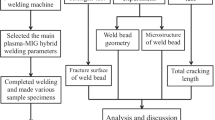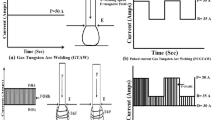Abstract
2219 aluminum alloy is one of the most extensively used materials for the fabrication of rocket fuel storage box. This paper aims at revealing effect of process parameters on tensile strength in 2219 aluminum alloy welded by means of the plasma-MIG hybrid welding method. Process parameters such as MIG voltage, plasma gas, plasma current, welding speed, wire feed speed, etc. play a major role in deciding the joint tensile strength. An attempt has been made to establish an empirical relationship between process parameters and the tensile strength by applying a second-order regression model. A central composite design was applied to perform experiments for obtaining input-output data. The established model was tested for its adequacy and significance. Influences of single factor and interactive effect on tensile strength were analyzed. The maximum tensile strength of 2219 aluminum alloy jointed by plasma-MIG hybrid welding was 289.6 MPa.
Similar content being viewed by others
References
Zhang J, Chen BQ, Zhang BX (2012) Effect of initial microstructure on the hot compression deformation behavior of a 2219 aluminum alloy. Mater Des 34:15–21
Xu WF, Liu JH, Chen DL, Luan GH (2014) Low-cycle fatigue of a friction stir welded 2219-T62 aluminum alloy at different welding parameters and cooling conditions. Int J Adv Manuf Technol 74(1-4):209–218
Li JQ, Liu HJ (2015) Optimization of welding parameters for the reverse dual-rotation friction stir welding of a high-strength aluminum alloy 2219-T6. Int J Adv Manuf Technol 76(5-8):1469–1478
Sevim I, Hayat F, Kaya Y, Kahraman N, Sahin S (2013) The study of MIG weldability of heat-treated aluminum alloys. Int J Adv Manuf Technol 66(9-12):1825–1834
Tasak E, Jastrzebski A (2012) The influence of pulsation of the MIG arc on the structure of aluminium alloy welds. Weld Int 26(12):944–948
Shinichi T, Hiroshi S, Manabu T (2011) Experimental observation of cleaning action of cathode spots in AC TIG welding of aluminum plates. Q J Jpn Weld Soc 29(3):5–8
Atabaki MM, Ma J, Liu W, Kovacevic R (2015) Hybrid laser/arc welding of advanced high strength steel to aluminum alloy by using structural transition insert. Mater Des 75:120–135
Zhang C, Gao M, Li G, Chen C, Zeng XY (2013) Strength improving mechanism of laser arc hybrid welding of wrought AA 2219 aluminium alloy using AlMg5 wire. Sci Technol Weld Join 18(8):703–710
Faraji AH, Goodarzi M, Seyedein SH, Barbieri G, Maletta C (2015) Numerical modeling of heat transfer and fluid flow in hybrid laser-TIG welding of aluminum alloy AA6082. Int J Adv Manuf Technol 77(9-12):2067–2082
Tarasov SY, Rubtsov VE, Kolubaev EA (2014) A proposed diffusion-controlled wear mechanism of alloy steel friction stir welding (FSW) tools used on an aluminum alloy. Wear 318(1-2):130–134
D'Urso G, Giardini C, Lorenzi S, Pastore T (2014) Fatigue crack growth in the welding nugget of FSW joints of a 6060 aluminum alloy. J Mater Process Technol 214(10):2075–2084
Terasaki H, Simpson SW (2005) Modelling of the GMAW system in free flight and short circuiting transfer. Sci Technol Weld Join 10(1):120–124
Jelmorini G, Tichelaar GW, Essers WG, Willems AM, Coops H (1975) Welding characteristics of the plasma-MIG process. Metal Construct 7(1):568–572
Essers WG, Jelmorini G, Tichelaar GW (1972) Arc characteristics and metal transfer with Plasma-MIG welding. Met Constr 4(12):439–447
Baune E, Bonnet C, Liu S (2001) Assessing metal transfer stability and spatter severity in flux cored arc welding. Sci Technol Weld Join 6(3):139–148
Yang T, Gao HM, Zhang SH (2013) The study on plasma-MIG hybrid arc behavior and droplet transfer for mild steel welding. Rev Mater Sci 6(3):459–463
Miranda HC, Scotti A, Ferraresi VA (2007) Identification and control of metal transfer in pulsed GMAW using optical sensor. Sci Technol Weld Join 12(3):249–157
Ono K, Liu ZJ, Era T, Uezono T, Ueyama T, Tanaka M, Nakata K (2003) Development of a plasma MIG welding system for aluminum. Weld Int 23(11):805–809
Zhu PY, Rados M, Simpson SW (1995) A theoretical-study of a gas metal arc welding system. Plasma Sci Technol 4(3):495–500
Elangovan K, Balasubramanian V, Babu S (2008) Developing an empirical relationship to predict tensile strength of friction stir welded AA2219 aluminum alloy. J Mater Eng Perform 17(6):820–830
Gopi S, Manonmani K (2012) Predicting tensile strength of double side friction stir welded 6082-T6 aluminium alloy. Sci Technol Weld Join 17(7):601–607
Singh G, Singh K, Singh J (2014) Modeling of the effect of process parameters on tensile strength of friction stir welded aluminium alloy joints. Exp Tech 38(3):63–71
He H, Yang CL, Chen Z, Lin SB, Fan CL (2014) Strength prediction of aluminum-stainless steel-pulsed TIG welding-brazing joints with RSM and ANN. Acta Metal Sin-Engl 27(6):1012–1017
Montgomery DC (2003) Design and analysis of experiments. Wiley (Asia), Singapore
Davies OL (1978) The design and analysis of industrial experiments. Longmen, New York
Kou S, Wang YH (1986) Weld pool convention and its effect. Weld J 65(3):63–70
Kou S, Sun DK (1985) Fluid flow and weld penetration in stationary arc welds. Metall Trans A 16A:203–213
Yang CL, Lin SB (2003) Arc welding base. HIT Press, Harbin, pp 54–72
Yang T, Xu KW, Wu L (2013) Analysis on ARC characteristics of plasma-MIG hybrid arc welding. Trans China Weld Inst 34(5):62–66
Yang T, Zhang SH, Gao HM, Wu L, Xu KW, Liu YZ (2012) Analysis of mechanism for TIG-MIG hybrid arc properties. Trans China Weld Inst 33(7):25–28
Author information
Authors and Affiliations
Corresponding author
Rights and permissions
About this article
Cite this article
Yang, T., Xiong, J. & Chen, H. Effect of process parameters on tensile strength in plasma-MIG hybrid welding for 2219 aluminum alloy. Int J Adv Manuf Technol 84, 2413–2421 (2016). https://doi.org/10.1007/s00170-015-7901-9
Received:
Accepted:
Published:
Issue Date:
DOI: https://doi.org/10.1007/s00170-015-7901-9




